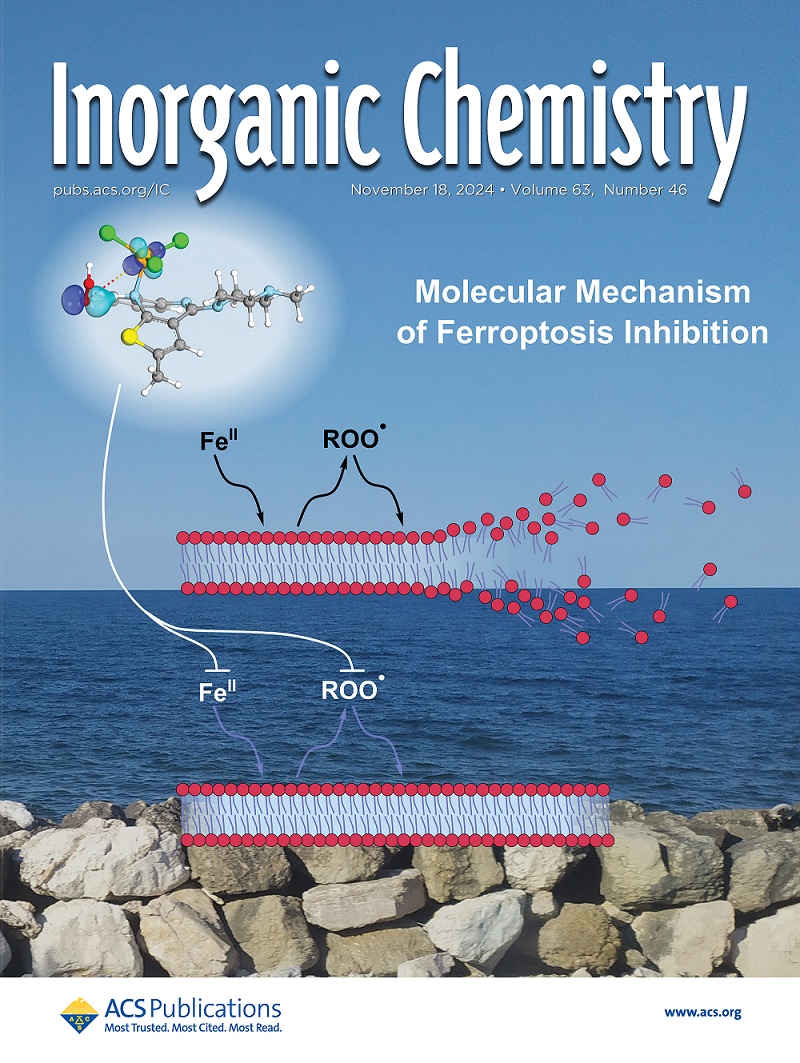增强过氧化物酶类活性的铁单原子催化剂轴向氮配位工程。
IF 4.3
2区 化学
Q1 CHEMISTRY, INORGANIC & NUCLEAR
引用次数: 0
摘要
模拟天然辣根过氧化物酶(HRP)的层次结构和不对称的Fe-N5位点,对开发具有高过氧化物酶样(POD-like)活性的Fe1/CN具有重要意义。本文采用氨辅助再分散策略制备了具有不对称FeN5基团和有序多孔结构的Fe1/CN (FeN5/CN),其结构与HRP具有很高的相似性。因此,FeN5/CN在类pod反应中表现出优异的催化效率(比活度= 117.9 U/mg, kcat/Km = 2185 mM-1 s-1)和选择性(Km = 0.059 mM)。基于FeN5/CN的高催化性能,组装了一种检测下限为3.1 nM的硫丹检测传感器。有趣的是,FeN5/CN通过超氧途径激活H2O2,而在FeN4/CN参与的催化体系中都可以检测到·OH、1O2和·O2-。通过密度泛函数理论计算并结合实验结果进行机理研究表明,Fe-N5位点对*OH具有适度的吸附作用,分别增大和减小反应能生成·OH和·O2-,而Fe-N4位点对OH*中间体具有较高的亲和力,导致H2O2分子的O-O键容易断裂,阻止*OH解吸生成·OH。本文章由计算机程序翻译,如有差异,请以英文原文为准。
Axial Nitrogen Coordination Engineering of Fe Single-Atom Catalyst for Enhanced Peroxidase-like Activity.
Mimicking the hierarchical structure as well as the asymmetric Fe-N5 sites in natural horseradish peroxidase (HRP) is of great importance in developing Fe1/CN with high peroxidase-like (POD-like) activity. In this work, Fe1/CN with an asymmetric FeN5 moiety and ordered porous structure (FeN5/CN) is fabricated by an ammonia-assisted redispersion strategy, which shows high structural similarity with HRP. Therefore, FeN5/CN shows an excellent catalytic efficiency (specific activity = 117.9 U/mg, kcat/Km = 2185 mM-1 s-1) and selectivity (Km = 0.059 mM) in a POD-like reaction. Based on the high catalytic properties of FeN5/CN, a sensor for the detection of carbosulfan with a low limit of detection of 3.1 nM is assembled. Interestingly, FeN5/CN activates H2O2 via a superoxide pathway, while ·OH, 1O2, and ·O2- can all be detected in the FeN4/CN involved catalytic system. Mechanistic study by density functional theory calculations combined with experimental results illustrates that Fe-N5 sites provide moderate adsorption of *OH, enlarging and decreasing the reaction energy to form ·OH and ·O2-, respectively, while Fe-N4 sites exhibited higher affinity toward the OH* intermediate, resulting in the facile O-O bond cleavage from H2O2 molecule and prohibited the process of *OH desorption to ·OH.
求助全文
通过发布文献求助,成功后即可免费获取论文全文。
去求助
来源期刊

Inorganic Chemistry
化学-无机化学与核化学
CiteScore
7.60
自引率
13.00%
发文量
1960
审稿时长
1.9 months
期刊介绍:
Inorganic Chemistry publishes fundamental studies in all phases of inorganic chemistry. Coverage includes experimental and theoretical reports on quantitative studies of structure and thermodynamics, kinetics, mechanisms of inorganic reactions, bioinorganic chemistry, and relevant aspects of organometallic chemistry, solid-state phenomena, and chemical bonding theory. Emphasis is placed on the synthesis, structure, thermodynamics, reactivity, spectroscopy, and bonding properties of significant new and known compounds.
 求助内容:
求助内容: 应助结果提醒方式:
应助结果提醒方式:


